1997 FORD TAURUS ESP
[x] Cancel search: ESPPage 55 of 167
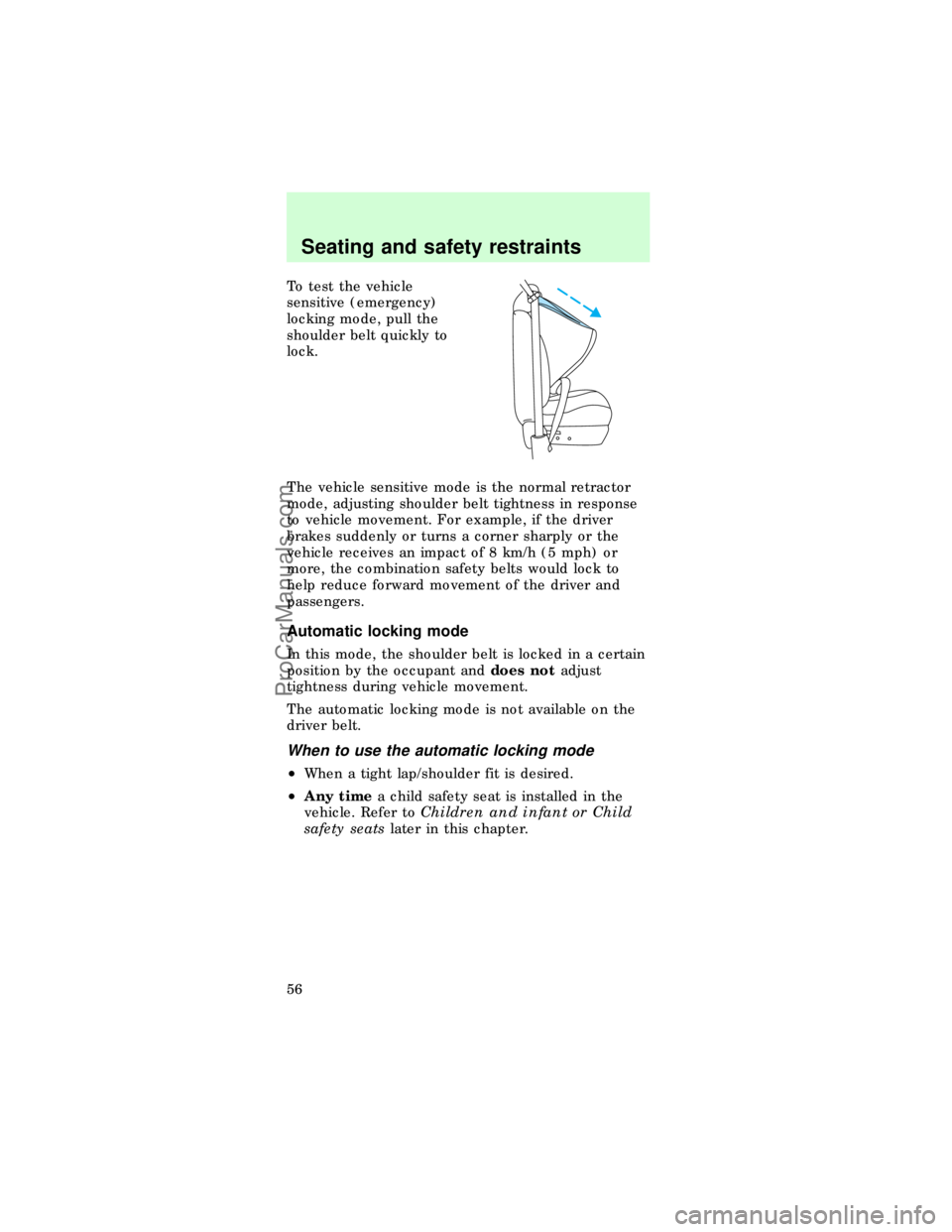
To test the vehicle
sensitive (emergency)
locking mode, pull the
shoulder belt quickly to
lock.
The vehicle sensitive mode is the normal retractor
mode, adjusting shoulder belt tightness in response
to vehicle movement. For example, if the driver
brakes suddenly or turns a corner sharply or the
vehicle receives an impact of 8 km/h (5 mph) or
more, the combination safety belts would lock to
help reduce forward movement of the driver and
passengers.
Automatic locking mode
In this mode, the shoulder belt is locked in a certain
position by the occupant anddoes notadjust
tightness during vehicle movement.
The automatic locking mode is not available on the
driver belt.
When to use the automatic locking mode
²When a tight lap/shoulder fit is desired.
²Any timea child safety seat is installed in the
vehicle. Refer toChildren and infant or Child
safety seatslater in this chapter.
Seating and safety restraints
56
ProCarManuals.com
Page 66 of 167
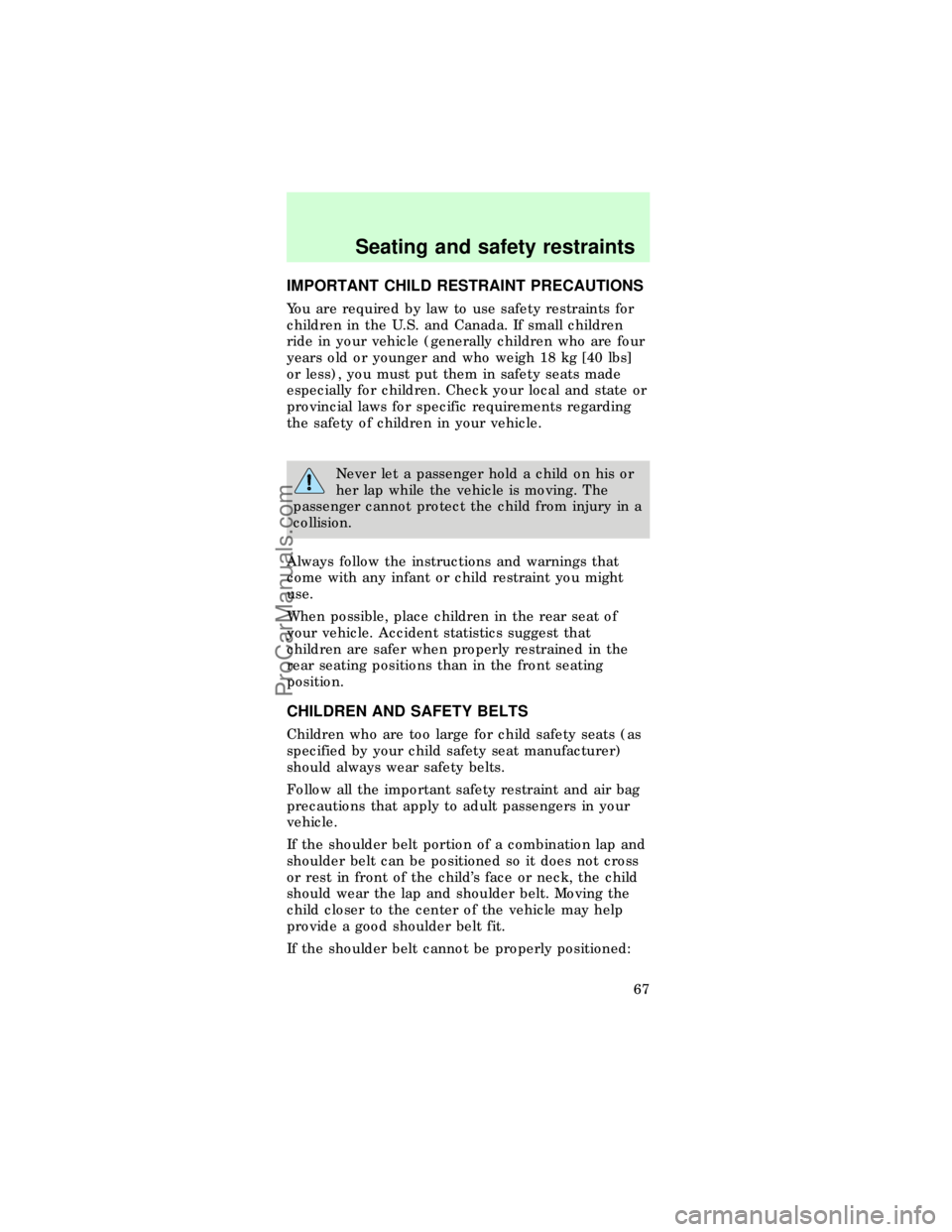
IMPORTANT CHILD RESTRAINT PRECAUTIONS
You are required by law to use safety restraints for
children in the U.S. and Canada. If small children
ride in your vehicle (generally children who are four
years old or younger and who weigh 18 kg [40 lbs]
or less), you must put them in safety seats made
especially for children. Check your local and state or
provincial laws for specific requirements regarding
the safety of children in your vehicle.
Never let a passenger hold a child on his or
her lap while the vehicle is moving. The
passenger cannot protect the child from injury in a
collision.
Always follow the instructions and warnings that
come with any infant or child restraint you might
use.
When possible, place children in the rear seat of
your vehicle. Accident statistics suggest that
children are safer when properly restrained in the
rear seating positions than in the front seating
position.
CHILDREN AND SAFETY BELTS
Children who are too large for child safety seats (as
specified by your child safety seat manufacturer)
should always wear safety belts.
Follow all the important safety restraint and air bag
precautions that apply to adult passengers in your
vehicle.
If the shoulder belt portion of a combination lap and
shoulder belt can be positioned so it does not cross
or rest in front of the child's face or neck, the child
should wear the lap and shoulder belt. Moving the
child closer to the center of the vehicle may help
provide a good shoulder belt fit.
If the shoulder belt cannot be properly positioned:
Seating and safety restraints
67
ProCarManuals.com
Page 78 of 167

Make sure the corresponding lights illuminate
briefly. If a light fails to illuminate, have the vehicle
serviced.
²If the driver's safety belt is fastened, the
light
does not illuminate.
Important safety precautions
A computer system controls the engine's idle
revolutions per minute (RPM). When the engine
starts, the idle RPM runs faster to warm the engine.
CRUISE
RPMx1000
0 1234
5
6
7EFC H
FUEL DOOR>
SERVICE
ENGINE
SOON1020304050 60
70
80
90
100
110
00 20406080100
120
140
160
180P R N D D 1MPH km/h
00
122
00013
P!
BRAKEABS
+ –
UNLEADED FUEL ONLY
THEFT LOW
COOLANTO/D
OFFREAR
LAMP
OUT
EFC H
FUEL DOOR>
SERVICE
ENGINE
SOONTHEFT102030405060
70
80
90
100
1202060100
140
180
P R N D 2 1MPH km/h
00
000
00000
P!
BRAKELOW
COOLANT
+ –
110CRUISE
RPMx1000
ABSO/D
OFFREAR
LAMP
OUTPREMIUM UNLEADED
FUEL RECOMMENDED0 1234
5
6
78
RPMx1000
0 1234
5
6
7EFC H
FUEL DOOR>
SERVICE
ENGINE
SOON1020304050607080
90
100
110
00 204080
60100120
140
160
180
220
240P R N 2 1
DMPH
km/h
00
000
00000
P!
BRAKEABSO/D
OFF
+ –
8
120
130
140
150
CRUISELOW
COOLANTTHEFT
200PREMIUM UNLEADED
FUEL RECOMMENDED
Starting
79
ProCarManuals.com
Page 80 of 167
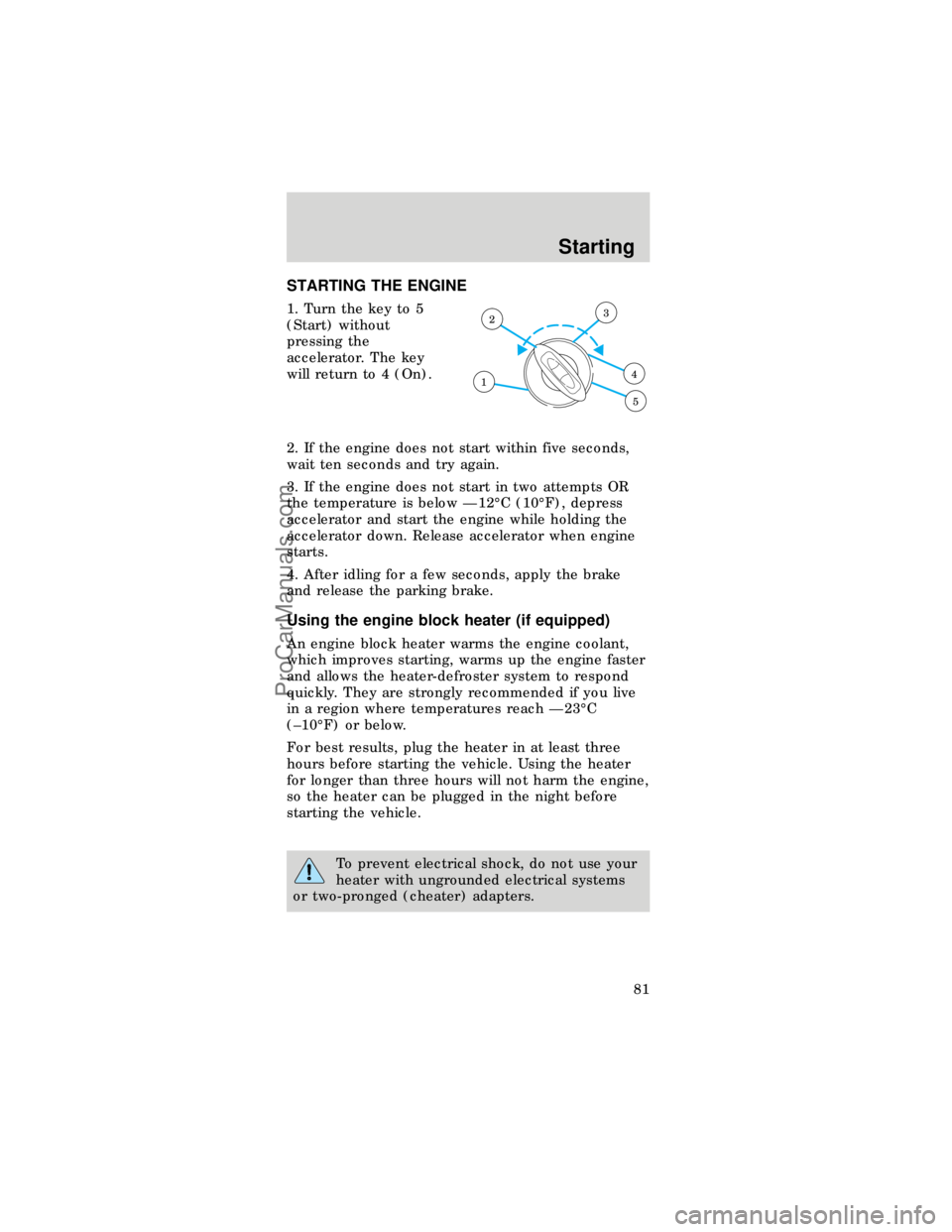
STARTING THE ENGINE
1. Turn the key to 5
(Start) without
pressing the
accelerator. The key
will return to 4 (On).
2. If the engine does not start within five seconds,
wait ten seconds and try again.
3. If the engine does not start in two attempts OR
the temperature is below Ð12ÉC (10ÉF), depress
accelerator and start the engine while holding the
accelerator down. Release accelerator when engine
starts.
4. After idling for a few seconds, apply the brake
and release the parking brake.
Using the engine block heater (if equipped)
An engine block heater warms the engine coolant,
which improves starting, warms up the engine faster
and allows the heater-defroster system to respond
quickly. They are strongly recommended if you live
in a region where temperatures reach Ð23ÉC
(±10ÉF) or below.
For best results, plug the heater in at least three
hours before starting the vehicle. Using the heater
for longer than three hours will not harm the engine,
so the heater can be plugged in the night before
starting the vehicle.
To prevent electrical shock, do not use your
heater with ungrounded electrical systems
or two-pronged (cheater) adapters.
1
23
4
5
Starting
81
ProCarManuals.com
Page 117 of 167
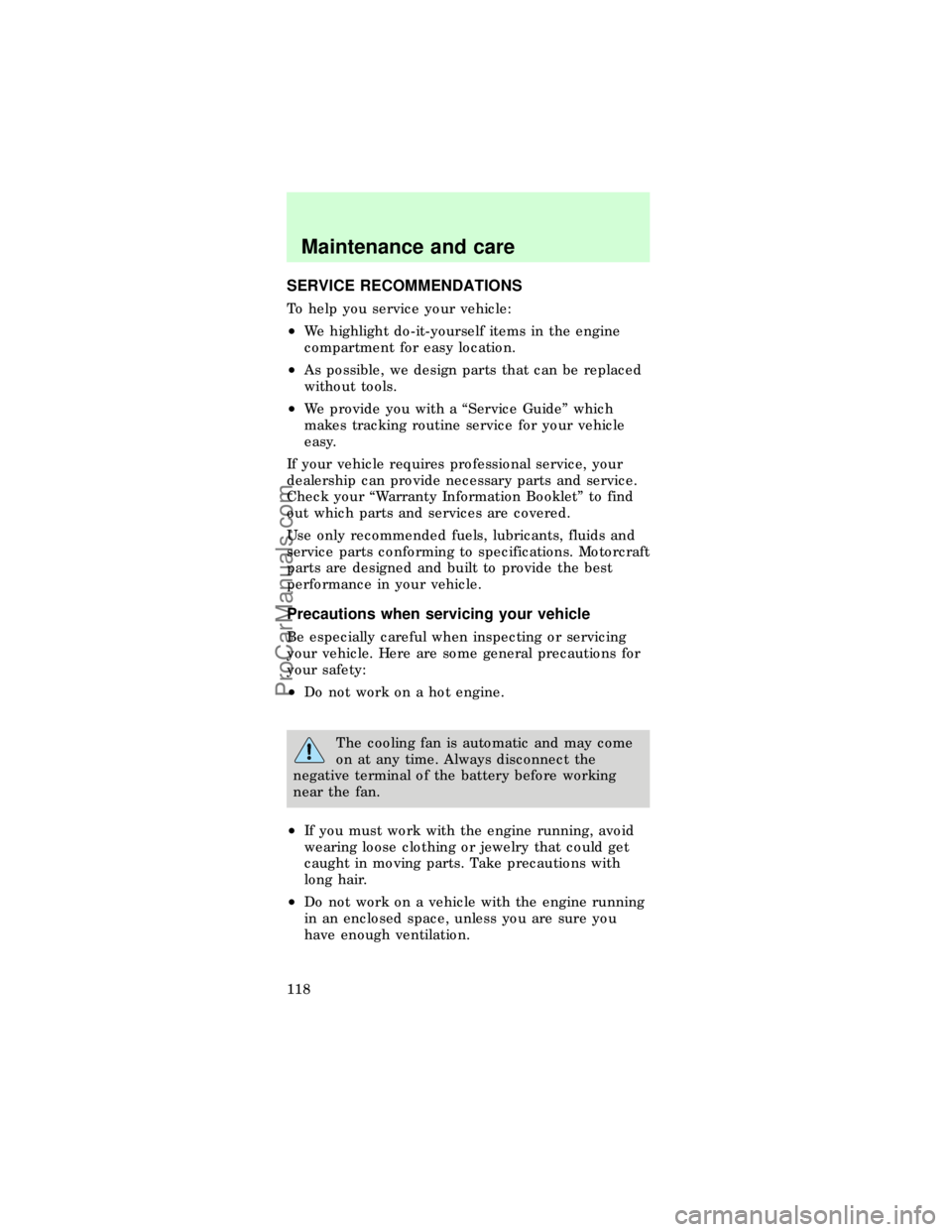
SERVICE RECOMMENDATIONS
To help you service your vehicle:
²We highlight do-it-yourself items in the engine
compartment for easy location.
²As possible, we design parts that can be replaced
without tools.
²We provide you with a ªService Guideº which
makes tracking routine service for your vehicle
easy.
If your vehicle requires professional service, your
dealership can provide necessary parts and service.
Check your ªWarranty Information Bookletº to find
out which parts and services are covered.
Use only recommended fuels, lubricants, fluids and
service parts conforming to specifications. Motorcraft
parts are designed and built to provide the best
performance in your vehicle.
Precautions when servicing your vehicle
Be especially careful when inspecting or servicing
your vehicle. Here are some general precautions for
your safety:
²Do not work on a hot engine.
The cooling fan is automatic and may come
on at any time. Always disconnect the
negative terminal of the battery before working
near the fan.
²If you must work with the engine running, avoid
wearing loose clothing or jewelry that could get
caught in moving parts. Take precautions with
long hair.
²Do not work on a vehicle with the engine running
in an enclosed space, unless you are sure you
have enough ventilation.
Maintenance and care
118
ProCarManuals.com
Page 127 of 167

2. When the engine is cool, wrap a thick cloth
around the cap. Slowly turn cap counterclockwise to
the first stop.
3. Step back while the pressure releases.
4. When you are sure that all the pressure has been
released, use the cloth to press the cap down, turn
it counterclockwise and remove it.
Use Ford Premium Cooling System Fluid
E2FZ-19549±AA (in Canada, Motorcraft CXC-8±B)
or an equivalent premium engine coolant that meets
Ford specification ESE-M97B44±A. Ford Premium
Engine Coolant is an optimized formula that will
protect all metals and rubber elastomers used in
Ford cooling systems for four years or 80,000 km
(50,000 miles).
Do not use alcohol or methanol antifreeze or any
engine coolants mixed with alcohol or methanol
antifreeze. Do not use supplemental coolant
additives in your vehicle. These additives may harm
your engine cooling system. The use of an improper
coolant may void your warranty of your vehicle's
engine cooling system.
Recycled engine coolant
Ford Motor Company recommends that Ford and
Lincoln-Mercury dealers use recycled engine coolant
produced by Ford-approved processes. Not all
coolant recycling processes produce coolant which
meets Ford specification ESE-M97B44±A, and use of
such coolant may harm engine and cooling system
components.
Always dispose of used automotive fluids in a
responsible manner. Follow your community's
regulations and standards for recycling and disposing
of automotive fluids.
Maintenance and care
128
ProCarManuals.com
Page 131 of 167
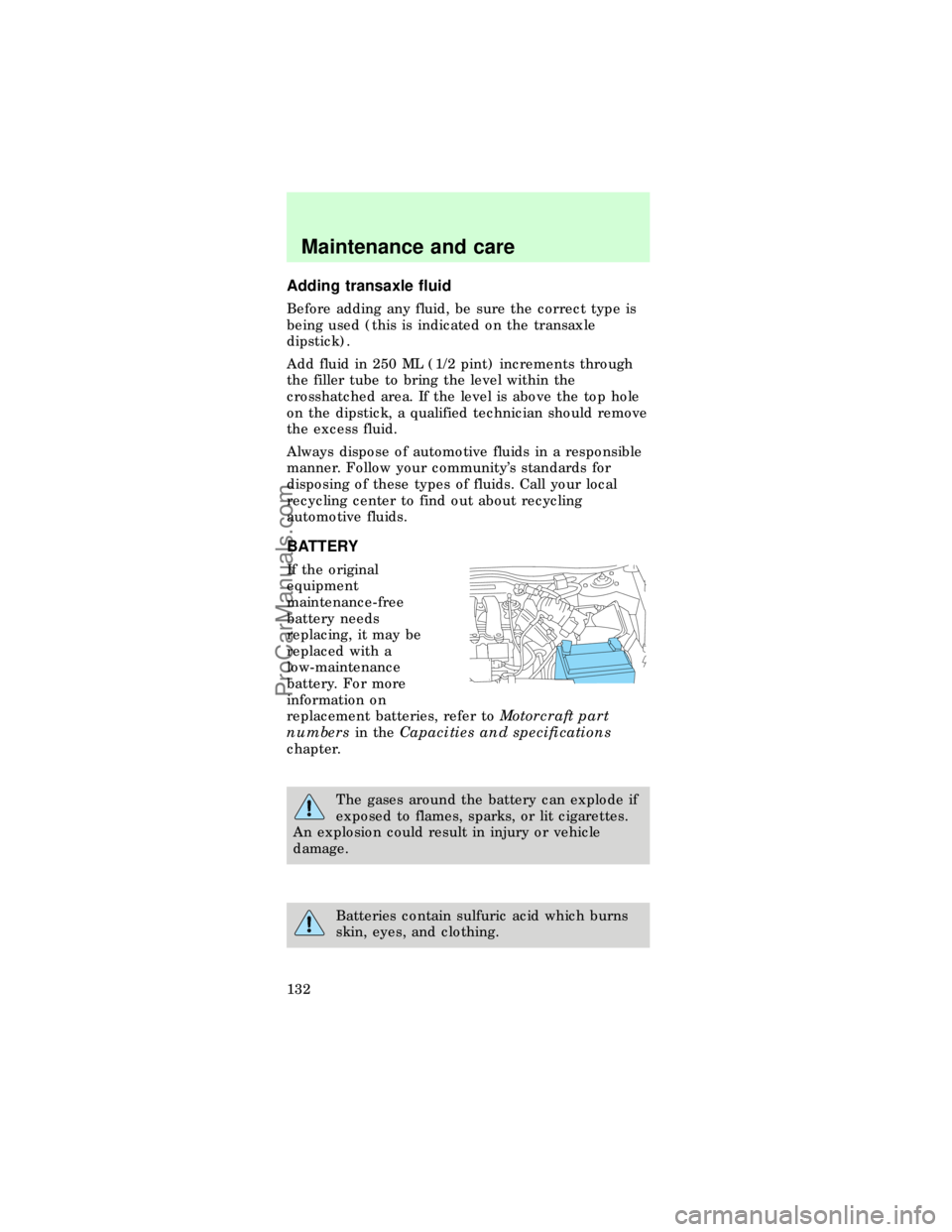
Adding transaxle fluid
Before adding any fluid, be sure the correct type is
being used (this is indicated on the transaxle
dipstick).
Add fluid in 250 ML (1/2 pint) increments through
the filler tube to bring the level within the
crosshatched area. If the level is above the top hole
on the dipstick, a qualified technician should remove
the excess fluid.
Always dispose of automotive fluids in a responsible
manner. Follow your community's standards for
disposing of these types of fluids. Call your local
recycling center to find out about recycling
automotive fluids.
BATTERY
If the original
equipment
maintenance-free
battery needs
replacing, it may be
replaced with a
low-maintenance
battery. For more
information on
replacement batteries, refer toMotorcraft part
numbersin theCapacities and specifications
chapter.
The gases around the battery can explode if
exposed to flames, sparks, or lit cigarettes.
An explosion could result in injury or vehicle
damage.
Batteries contain sulfuric acid which burns
skin, eyes, and clothing.
Maintenance and care
132
ProCarManuals.com
Page 133 of 167
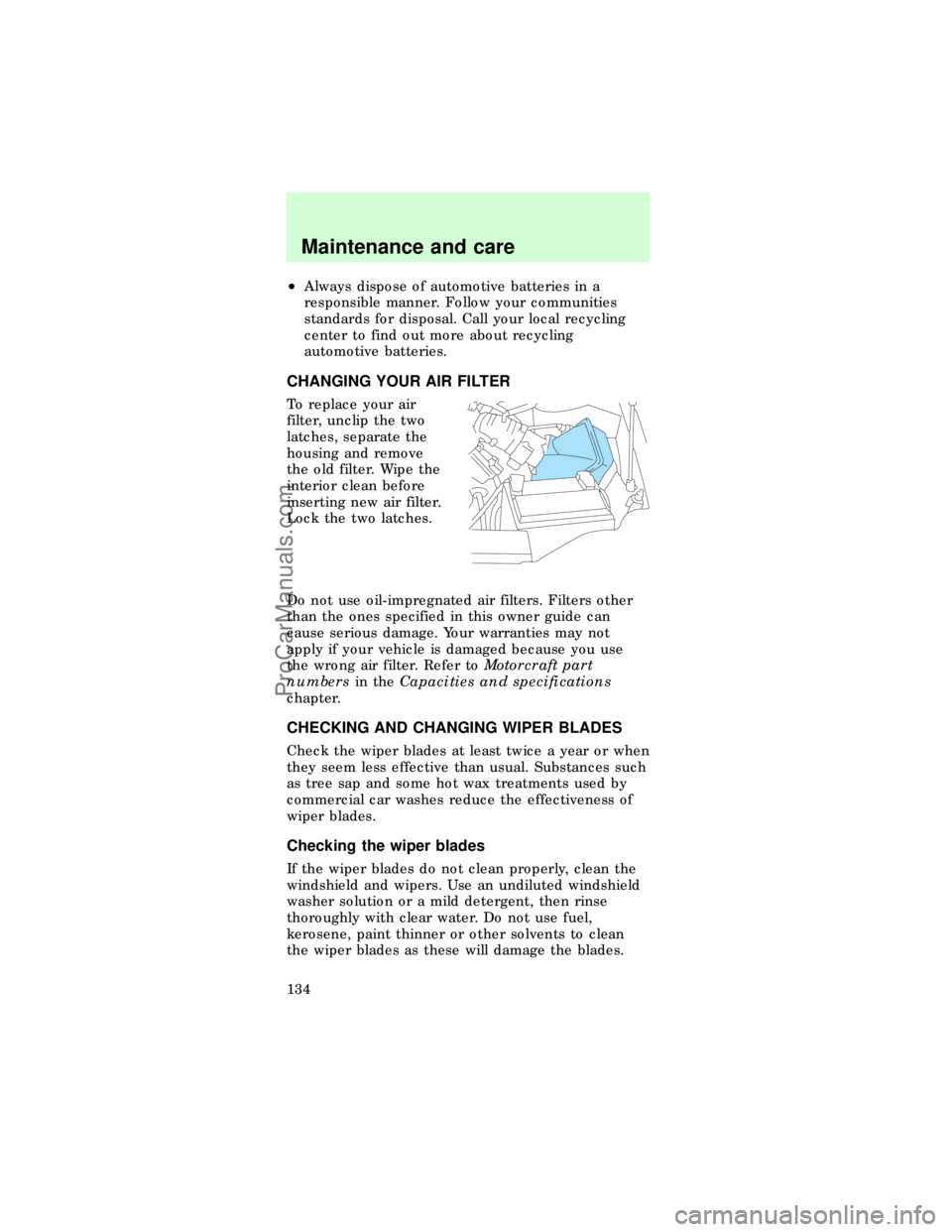
²Always dispose of automotive batteries in a
responsible manner. Follow your communities
standards for disposal. Call your local recycling
center to find out more about recycling
automotive batteries.
CHANGING YOUR AIR FILTER
To replace your air
filter, unclip the two
latches, separate the
housing and remove
the old filter. Wipe the
interior clean before
inserting new air filter.
Lock the two latches.
Do not use oil-impregnated air filters. Filters other
than the ones specified in this owner guide can
cause serious damage. Your warranties may not
apply if your vehicle is damaged because you use
the wrong air filter. Refer toMotorcraft part
numbersin theCapacities and specifications
chapter.
CHECKING AND CHANGING WIPER BLADES
Check the wiper blades at least twice a year or when
they seem less effective than usual. Substances such
as tree sap and some hot wax treatments used by
commercial car washes reduce the effectiveness of
wiper blades.
Checking the wiper blades
If the wiper blades do not clean properly, clean the
windshield and wipers. Use an undiluted windshield
washer solution or a mild detergent, then rinse
thoroughly with clear water. Do not use fuel,
kerosene, paint thinner or other solvents to clean
the wiper blades as these will damage the blades.
Maintenance and care
134
ProCarManuals.com